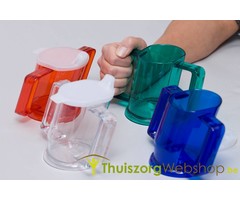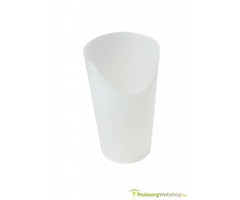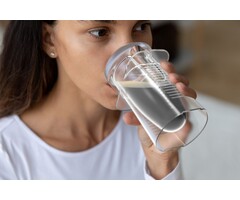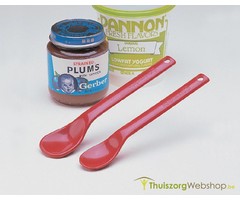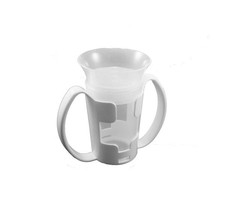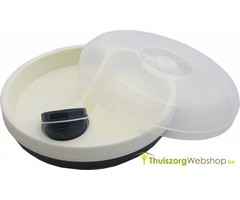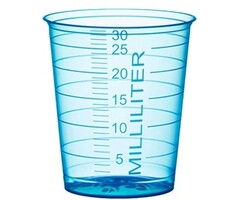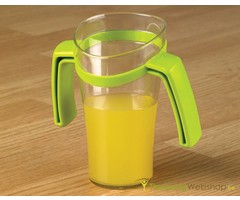
Swallow disorder
Swallowing difficulties can occur due to stroke, Parkinson's disease, muscle weakness, ALS , etc.
You swallow easier if you don't have to bend your head back. As possible solutions we offer a nose cup or angled cup. However, a discreet funnel-shaped or conical cup is the best alternative: less conspicuous and one can never hold it in the wrong way.
It is then quite a job to be able to eat and drink easily without needing the help of someone else. Another word for swallowing difficulties is also called dysphagia and when swallowing is impossible, this is called aphagia .
Swallowing difficulties can be life-threatening, since people can choke in such a way that they can suffocate. People with difficulty swallowing eat very slowly, can cough and sometimes drool.
In this category you will find adapted cups that facilitate drinking and adjustments that make drinking through a straw run more safely.
Swallowing difficulties (or dysphagia) is a general term for problems in the passage of solid or liquid components from the mouth to the stomach. That can even be saliva. In principle, breathing and swallowing are impossible at the same time. When we swallow something, our windpipe is always closed. The respiratory and digestive tracts intersect at the level of the pharynx (the pharynx), but when everything goes smoothly, that is no problem. Without thinking, we block our breathing as soon as we swallow: the palate closes off the nasal cavity (thus preventing nasal reflux), the epiglottis (throat valve) tilts to block access to the windpipe and closes the vocal cords itself, so that a double safety is created. Thus all access routes to the lungs are closed. The food is safely led to the esophagus and from there to the stomach.
Three phases
We swallow hundreds, not thousands of times a day: every time we swallow, eat, drink. Chronologically, this process takes place in three phases:
- the oral phase. We bring the food or drink into our mouths, with the lips, teeth and tongue playing an active role. We chew and mix the food with saliva.
- the throat phase. When the tongue pushes food back into the mouth, our body sends stimuli to the brain to close the airways. Everything happens automatically.
- the esophagus phase. Once past the intersection between the respiratory and digestive tracts, the upper part of the esophagus opens and the food slides into the esophagus.
An uncontrollable coughing
Esophageal problems manifest themselves in different ways: there may be difficulties in chewing and swallowing, there may be an accumulation of saliva, an overproduction of mucus, but it can also simply be a ... mistake. It can happen that the food or drink goes the wrong way. Part of what we had in the mouth ends up in the lungs and that causes a coughing, which removes the food from it again. But sometimes it happens that we breathe in a larger lump that can block the airways and cause asphyxiation. The only thing we can do ourselves at that moment is to cough as loudly as possible so that the food is coughed out. And if there is someone in the neighborhood, he can apply the Heimlich maneuver.
The possible consequences of these disorders are numerous. Because swallowing is painful, because of a feeling of blocking the food in the throat or because eating is always accompanied by coughing, some people eat and lose less weight, often without realizing it. However, they usually think that they eat enough and do not understand why they lose weight.
Another consequence is of a social nature. Eating together plays an important social role . People with swallowing problems, however, are no longer inclined to go to a restaurant or to visit family, fearing that they will choke in public. They will isolate themselves bit by bit, which can sometimes lead to depression.
Others will repeatedly experience respiratory problems without discovering the cause. For example, they will be treated every other time for bronchitis while the real cause is their swallowing problem.
The real causes
Swallowing problems can occur very suddenly: after a stroke or a brain haemorrhage, after a skull fracture or in people who have been intubated for some time for some medical reason. In other cases, the problem occurs much more gradually. It is often associated with neurological problems, for example in people with Parkinson's or multiple sclerosis. In this case, someone may have swallowing problems for several months, sometimes up to one or two years. If we tell someone like that he can be helped, he will be sorry he did not visit us before.
Swallowing problems can also occur with age because the sensitivity of the mouth and muscle strength diminishes. But also because the teeth no longer function as well or a dental prosthesis is poorly tolerated. Then the natural swallowing technique is disrupted.
Multidisciplinary rehabilitation
Speech therapy can also play an important role. With other stimuli (tones, sounds, ...) the problem is approached in a different way, complementary to ours. The fact that the various disciplines work together more intensively benefits the patient.
Dietitians are also involved in the rehabilitation process. If the patient has lost weight, sometimes malnourished, he will be advised to enrich his diet in a natural way. In particular, it is day-to-day products that are recommended to avoid having to resort to dietary supplements that are often very expensive.
But whatever remedies are used during rehabilitation, the aim is always to give the patient back his confidence as quickly as possible and to let him enjoy eating together again with others. Something that benefits both his health and his social life.
Swallowing difficulties can occur due to stroke, Parkinson's disease, muscle weakness, ALS , etc.
You swallow easier if you don't have to bend your head back. As possible solutions we offer a nose cup or angled cup. However, a discreet funnel-shaped or conical cup is the best alternative: less conspicuous and one can never hold it in the wrong way.
It is then quite a job to be able to eat and drink easily without needing the help of someone else. Another word for swallowing difficulties is also called dysphagia and when swallowing is impossible, this is called aphagia .
Swallowing difficulties can be life-threatening, since people can choke in such a way that they can suffocate. People with difficulty swallowing eat very slowly, can cough and sometimes drool.
In this category you will find adapted cups that facilitate drinking and adjustments that make drinking through a straw run more safely.
Swallowing difficulties (or dysphagia) is a general term for problems in the passage of solid or liquid components from the mouth to the stomach. That can even be saliva. In principle, breathing and swallowing are impossible at the same time. When we swallow something, our windpipe is always closed. The respiratory and digestive tracts intersect at the level of the pharynx (the pharynx), but when everything goes smoothly, that is no problem. Without thinking, we block our breathing as soon as we swallow: the palate closes off the nasal cavity (thus preventing nasal reflux), the epiglottis (throat valve) tilts to block access to the windpipe and closes the vocal cords itself, so that a double safety is created. Thus all access routes to the lungs are closed. The food is safely led to the esophagus and from there to the stomach.
Three phases
We swallow hundreds, not thousands of times a day: every time we swallow, eat, drink. Chronologically, this process takes place in three phases:
- the oral phase. We bring the food or drink into our mouths, with the lips, teeth and tongue playing an active role. We chew and mix the food with saliva.
- the throat phase. When the tongue pushes food back into the mouth, our body sends stimuli to the brain to close the airways. Everything happens automatically.
- the esophagus phase. Once past the intersection between the respiratory and digestive tracts, the upper part of the esophagus opens and the food slides into the esophagus.
An uncontrollable coughing
Esophageal problems manifest themselves in different ways: there may be difficulties in chewing and swallowing, there may be an accumulation of saliva, an overproduction of mucus, but it can also simply be a ... mistake. It can happen that the food or drink goes the wrong way. Part of what we had in the mouth ends up in the lungs and that causes a coughing, which removes the food from it again. But sometimes it happens that we breathe in a larger lump that can block the airways and cause asphyxiation. The only thing we can do ourselves at that moment is to cough as loudly as possible so that the food is coughed out. And if there is someone in the neighborhood, he can apply the Heimlich maneuver.
The possible consequences of these disorders are numerous. Because swallowing is painful, because of a feeling of blocking the food in the throat or because eating is always accompanied by coughing, some people eat and lose less weight, often without realizing it. However, they usually think that they eat enough and do not understand why they lose weight.
Another consequence is of a social nature. Eating together plays an important social role . People with swallowing problems, however, are no longer inclined to go to a restaurant or to visit family, fearing that they will choke in public. They will isolate themselves bit by bit, which can sometimes lead to depression.
Others will repeatedly experience respiratory problems without discovering the cause. For example, they will be treated every other time for bronchitis while the real cause is their swallowing problem.
The real causes
Swallowing problems can occur very suddenly: after a stroke or a brain haemorrhage, after a skull fracture or in people who have been intubated for some time for some medical reason. In other cases, the problem occurs much more gradually. It is often associated with neurological problems, for example in people with Parkinson's or multiple sclerosis. In this case, someone may have swallowing problems for several months, sometimes up to one or two years. If we tell someone like that he can be helped, he will be sorry he did not visit us before.
Swallowing problems can also occur with age because the sensitivity of the mouth and muscle strength diminishes. But also because the teeth no longer function as well or a dental prosthesis is poorly tolerated. Then the natural swallowing technique is disrupted.
Multidisciplinary rehabilitation
Speech therapy can also play an important role. With other stimuli (tones, sounds, ...) the problem is approached in a different way, complementary to ours. The fact that the various disciplines work together more intensively benefits the patient.
Dietitians are also involved in the rehabilitation process. If the patient has lost weight, sometimes malnourished, he will be advised to enrich his diet in a natural way. In particular, it is day-to-day products that are recommended to avoid having to resort to dietary supplements that are often very expensive.
But whatever remedies are used during rehabilitation, the aim is always to give the patient back his confidence as quickly as possible and to let him enjoy eating together again with others. Something that benefits both his health and his social life.
Swallowing difficulties can occur due to stroke, Parkinson's disease, muscle weakness, ALS , etc.
You swallow easier if you don't have to bend your head back. As possible solutions we offer a nose cup or angled cup. However, a discreet funnel-shaped or conical cup is the best alternative: less conspicuous and one can never hold it in the wrong way.
It is then quite a job to be able to eat and drink easily without needing the help of someone else. Another word for swallowing difficulties is also called dysphagia and when swallowing is impossible, this is called aphagia .
Swallowing difficulties can be life-threatening, since people can choke in such a way that they can suffocate. People with difficulty swallowing eat very slowly, can cough and sometimes drool.
In this category you will find adapted cups that facilitate drinking and adjustments that make drinking through a straw run more safely.
Swallowing difficulties (or dysphagia) is a general term for problems in the passage of solid or liquid components from the mouth to the stomach. That can even be saliva. In principle, breathing and swallowing are impossible at the same time. When we swallow something, our windpipe is always closed. The respiratory and digestive tracts intersect at the level of the pharynx (the pharynx), but when everything goes smoothly, that is no problem. Without thinking, we block our breathing as soon as we swallow: the palate closes off the nasal cavity (thus preventing nasal reflux), the epiglottis (throat valve) tilts to block access to the windpipe and closes the vocal cords itself, so that a double safety is created. Thus all access routes to the lungs are closed. The food is safely led to the esophagus and from there to the stomach.
Three phases
We swallow hundreds, not thousands of times a day: every time we swallow, eat, drink. Chronologically, this process takes place in three phases:
- the oral phase. We bring the food or drink into our mouths, with the lips, teeth and tongue playing an active role. We chew and mix the food with saliva.
- the throat phase. When the tongue pushes food back into the mouth, our body sends stimuli to the brain to close the airways. Everything happens automatically.
- the esophagus phase. Once past the intersection between the respiratory and digestive tracts, the upper part of the esophagus opens and the food slides into the esophagus.
An uncontrollable coughing
Esophageal problems manifest themselves in different ways: there may be difficulties in chewing and swallowing, there may be an accumulation of saliva, an overproduction of mucus, but it can also simply be a ... mistake. It can happen that the food or drink goes the wrong way. Part of what we had in the mouth ends up in the lungs and that causes a coughing, which removes the food from it again. But sometimes it happens that we breathe in a larger lump that can block the airways and cause asphyxiation. The only thing we can do ourselves at that moment is to cough as loudly as possible so that the food is coughed out. And if there is someone in the neighborhood, he can apply the Heimlich maneuver.
The possible consequences of these disorders are numerous. Because swallowing is painful, because of a feeling of blocking the food in the throat or because eating is always accompanied by coughing, some people eat and lose less weight, often without realizing it. However, they usually think that they eat enough and do not understand why they lose weight.
Another consequence is of a social nature. Eating together plays an important social role . People with swallowing problems, however, are no longer inclined to go to a restaurant or to visit family, fearing that they will choke in public. They will isolate themselves bit by bit, which can sometimes lead to depression.
Others will repeatedly experience respiratory problems without discovering the cause. For example, they will be treated every other time for bronchitis while the real cause is their swallowing problem.
The real causes
Swallowing problems can occur very suddenly: after a stroke or a brain haemorrhage, after a skull fracture or in people who have been intubated for some time for some medical reason. In other cases, the problem occurs much more gradually. It is often associated with neurological problems, for example in people with Parkinson's or multiple sclerosis. In this case, someone may have swallowing problems for several months, sometimes up to one or two years. If we tell someone like that he can be helped, he will be sorry he did not visit us before.
Swallowing problems can also occur with age because the sensitivity of the mouth and muscle strength diminishes. But also because the teeth no longer function as well or a dental prosthesis is poorly tolerated. Then the natural swallowing technique is disrupted.
Multidisciplinary rehabilitation
Speech therapy can also play an important role. With other stimuli (tones, sounds, ...) the problem is approached in a different way, complementary to ours. The fact that the various disciplines work together more intensively benefits the patient.
Dietitians are also involved in the rehabilitation process. If the patient has lost weight, sometimes malnourished, he will be advised to enrich his diet in a natural way. In particular, it is day-to-day products that are recommended to avoid having to resort to dietary supplements that are often very expensive.
But whatever remedies are used during rehabilitation, the aim is always to give the patient back his confidence as quickly as possible and to let him enjoy eating together again with others. Something that benefits both his health and his social life.

